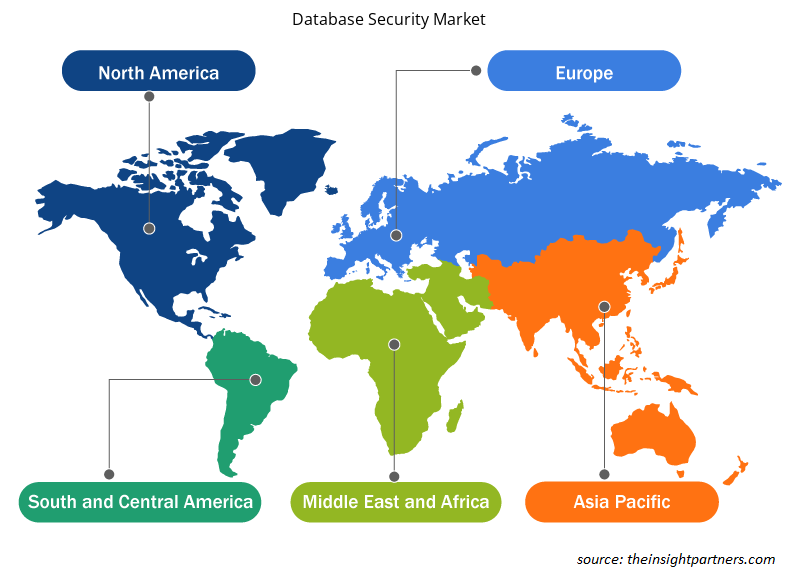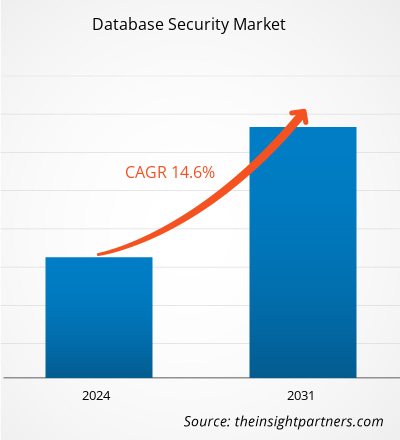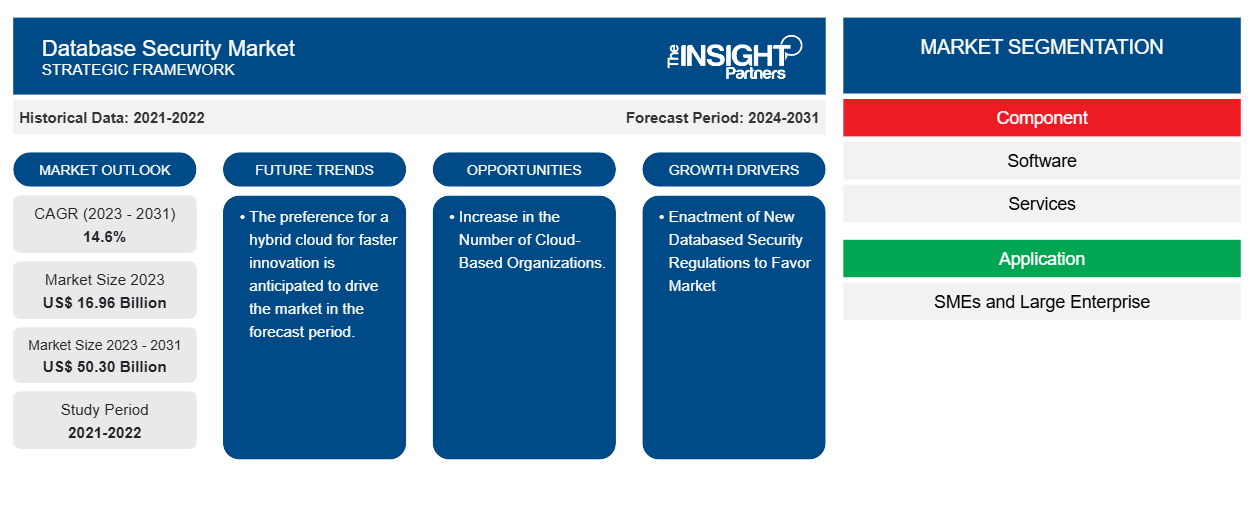Si prevede che la dimensione del mercato della sicurezza dei database raggiungerà i 50,30 miliardi di dollari entro il 2031, rispetto ai 16,96 miliardi di dollari del 2023. Si prevede che il mercato registrerà un CAGR del 14,6% nel periodo 2023-2031. L'emanazione di nuove normative sulla sicurezza dei database, i crescenti volumi di dati aziendali e l'aumento esponenziale del potenziale di attacchi informatici con la popolarità dell'IoT saranno probabilmente i principali driver e tendenze del mercato.CAGR of 14.6% during 2023–2031. The enactment of new database security regulations, growing volumes of business data and exponential rise in potential for cyberattacks with the popularity of IoT are likely to be the key drivers and trends of the market.
Analisi di mercato della sicurezza del database
Il mercato della sicurezza dei database sta vivendo una crescita significativa a livello globale. Questa crescita è attribuita a fattori quali l'emanazione di nuove normative sulla sicurezza dei database, i crescenti volumi di dati aziendali e l'aumento esponenziale del potenziale di attacchi informatici con la popolarità dell'IoT. Inoltre, si prevede che la proliferazione delle dimensioni e dei servizi delle organizzazioni basate sul cloud e la preferenza per il cloud ibrido per un'innovazione più rapida guideranno la crescita del mercato nei prossimi anni.
Panoramica del mercato della sicurezza dei database
La sicurezza dei database è considerata come la serie di controlli, strumenti e procedure progettati per garantire e salvaguardare integrità, riservatezza e accessibilità. Le leggi sulla sicurezza dei dati sono importanti per scopi che vanno oltre il semplice raggiungimento della conformità normativa . Questi includono:
- Garantire la riservatezza delle informazioni personali delle persone i cui dati vengono elaborati
- Ridurre al minimo i rischi di violazioni dei dati e minacce informatiche
- Mantenere l'affidabilità e l'accuratezza dei dati
- Creare un ambiente aziendale sano con una maggiore fiducia dei clienti
- Promuovere l'impegno verso la sicurezza informatica.
Personalizza questo report in base alle tue esigenze
Riceverai la personalizzazione gratuita di qualsiasi report, comprese parti di questo report, o analisi a livello nazionale, pacchetto dati Excel, oltre a usufruire di grandi offerte e sconti per start-up e università
- Scopri le principali tendenze di mercato in questo rapporto.Questo campione GRATUITO includerà analisi di dati che spaziano dalle tendenze di mercato alle stime e alle previsioni.
Driver e opportunità del mercato della sicurezza dei database
Emanazione di nuove norme sulla sicurezza dei database per favorire il mercato
Le normative sulla sicurezza dei database sono standard stabiliti da enti normativi o dal governo, che guidano le organizzazioni verso la protezione della riservatezza, integrità e disponibilità dei dati. Queste mirano essenzialmente a salvaguardare le risorse informative dell'azienda da distruzione, manomissione, accesso non autorizzato e altri rischi per la sicurezza. Inoltre, ci sono costi per la mancata conformità alle normative internazionali come il Sarbanes-Oxley Act (SAO) o lo standard di sicurezza dei dati del settore delle carte di pagamento (PCI DSS) specifici per le normative del settore sulla privacy dei dati, come HIPAA o leggi regionali sulla privacy come il Regolamento generale sulla protezione dei dati (GDPR) dell'Unione Europea, che potrebbero essere un problema chiave con multe nei casi peggiori superiori a molti milioni di dollari per ogni violazione.Sarbanes-Oxley Act (SAO) or payment card industry data security standard (PCI DSS) specific to industry regulations on data privacy, like HIPAA or regional privacy laws like the European Union's General Data Protection Regulation (GDPR) could be a key problem with fines in worst cases in excess of many million dollars for each violation.
Aumento del numero di organizzazioni basate sul cloud.
Ci sono un gran numero di organizzazioni basate su cloud sul mercato, tra cui AWS, VMWare, Oracle, NetApp, Salesforce, Google, IBM e molte altre. Queste organizzazioni comprendono grandi quantità di database. Considerando questo, il rischio di violazioni dei dati e phishing dei dati è aumentato. Una minaccia specifica per i database è l'introduzione di SQL non veritieri e di altri attacchi di stringhe non SQL nelle query per i database forniti da app basate sul Web e intestazioni HTTP. Le aziende che non seguono pratiche di codifica sicure per le applicazioni Web e non conducono regolari test di esposizione sono suscettibili agli attacchi che li utilizzano.VMWare, Oracle, NetApp, Salesforce, Google, IBM, and many more. These organizations comprise large amounts of databases. Considering this, the risk of data breaches and data phishing is increased. A specific threat to databases is the introducing of untrue SQL as well as other non-SQL string attacks in queries for databases delivered by web-based apps and HTTP headers. Companies that do not follow safe
Analisi della segmentazione del rapporto di mercato sulla sicurezza del database
I segmenti chiave che hanno contribuito alla derivazione dell'analisi di mercato della sicurezza dei database sono i componenti, le applicazioni e il settore verticale.verticle.
- In base al componente, il mercato della sicurezza del database è diviso in software e servizi. Si prevede che il segmento software detenga una quota di mercato significativa nel periodo di previsione.
- In base all'applicazione, il mercato della sicurezza dei database è suddiviso in PMI e grandi imprese. Si prevede che il segmento PMI deterrà una quota di mercato significativa nel periodo di previsione.SMEs and large enterprises. The SME segment is anticipated to hold a significant market share in the forecast period.
- Per settore verticale, il mercato è segmentato in BFSI, IT e telecomunicazioni, produzione, sanità, governo, vendita al dettaglio e altri). Si prevede che IT e telecomunicazioni deterranno una quota di mercato significativa nel periodo di previsione.verticle, the market is segmented into BFSI, IT and telecom, manufacturing, healthcare, government, retail, and others). The IT and telecom is anticipated to hold a significant market share in the forecast period.
Analisi della quota di mercato della sicurezza dei database per area geografica
L'ambito geografico del rapporto sul mercato della sicurezza dei database è suddiviso principalmente in cinque regioni: Nord America, Asia Pacifico, Europa, Medio Oriente e Africa, Sud e Centro America.
Il Nord America ha dominato il mercato della sicurezza dei database. Le tendenze di adozione di tecnologie elevate in vari settori nella regione nordamericana hanno alimentato la crescita del mercato della sicurezza dei database. Fattori come il crescente numero di organizzazioni basate sul cloud. Inoltre, una forte enfasi sulla ricerca e sviluppo nelle economie sviluppate degli Stati Uniti e del Canada sta costringendo i player nordamericani a portare sul mercato soluzioni tecnologicamente avanzate. Inoltre, gli Stati Uniti hanno un gran numero di player del mercato della sicurezza dei database che si sono sempre più concentrati sullo sviluppo di soluzioni innovative. Tutti questi fattori contribuiscono alla crescita del mercato della sicurezza dei database nella regione.fuelled the growth of the database security market. Factors such as the increasing number of cloud-based organizations. Moreover, a strong emphasis on research and development in the developed economies of the US and Canada is forcing the North American players to bring technologically advanced solutions into the market. In addition, the US has a large number of database security market players who have been increasingly focusing on developing innovative solutions. All these factors contribute to the region's growth of the database security market.
Approfondimenti regionali sul mercato della sicurezza dei database
Le tendenze regionali e i fattori che influenzano il Database Security Market durante il periodo di previsione sono stati ampiamente spiegati dagli analisti di Insight Partners. Questa sezione discute anche i segmenti del Database Security Market e la geografia in Nord America, Europa, Asia Pacifico, Medio Oriente e Africa e Sud e Centro America.

- Ottieni i dati specifici regionali per il mercato della sicurezza del database
Ambito del rapporto di mercato sulla sicurezza del database
| Attributo del report | Dettagli |
|---|---|
| Dimensioni del mercato nel 2023 | 16,96 miliardi di dollari USA |
| Dimensioni del mercato entro il 2031 | 50,30 miliardi di dollari USA |
| CAGR globale (2023-2031) | 14,6% |
| Dati storici | 2021-2022 |
| Periodo di previsione | 2024-2031 |
| Segmenti coperti | Per componente
|
| Regioni e Paesi coperti | America del Nord
|
| Leader di mercato e profili aziendali chiave |
|
Densità degli attori del mercato della sicurezza dei database: comprendere il suo impatto sulle dinamiche aziendali
Il mercato della sicurezza dei database sta crescendo rapidamente, spinto dalla crescente domanda degli utenti finali dovuta a fattori quali l'evoluzione delle preferenze dei consumatori, i progressi tecnologici e una maggiore consapevolezza dei vantaggi del prodotto. Con l'aumento della domanda, le aziende stanno ampliando le loro offerte, innovando per soddisfare le esigenze dei consumatori e capitalizzando sulle tendenze emergenti, il che alimenta ulteriormente la crescita del mercato.
La densità degli operatori di mercato si riferisce alla distribuzione di aziende o società che operano in un particolare mercato o settore. Indica quanti concorrenti (operatori di mercato) sono presenti in un dato spazio di mercato in relazione alle sue dimensioni o al valore di mercato totale.
Le principali aziende che operano nel mercato della sicurezza dei database sono:
- Società anonima
- SAP SE
- ScalaGriglia
- MICROFOCUS
- Talete
- Società Oracle
Disclaimer : le aziende elencate sopra non sono classificate secondo un ordine particolare.

- Ottieni una panoramica dei principali attori del mercato della sicurezza dei database
Notizie di mercato e sviluppi recenti sulla sicurezza dei database
Il mercato della sicurezza dei database viene valutato raccogliendo dati qualitativi e quantitativi dopo la ricerca primaria e secondaria, che include importanti pubblicazioni aziendali, dati associativi e database. Di seguito sono elencati alcuni degli sviluppi nel mercato della sicurezza dei database:
- Microsoft Corp. e Oracle stanno ampliando la collaborazione per soddisfare la crescente domanda dei clienti per Oracle Database@Azure in tutto il mondo. Oracle Database@Azure si espanderà in altre cinque regioni, il che porta l'impronta di disponibilità multicloud pianificata totale a 15 regioni a livello globale. (Fonte: Oracle Company Website, marzo 2024)
- CrowdStrike e Cloudflare, Inc., l'azienda leader nel cloud per la connettività, stanno espandendo la loro partnership strategica per connettere le loro piattaforme e migliorare la sicurezza dal dispositivo alla rete, accelerare la trasformazione del Security Operations Center (SOC) e fermare le violazioni prima che si verifichino. (Fonte: sito Web aziendale CrowdStrike, giugno 2024)
Copertura e risultati del rapporto sul mercato della sicurezza dei database
Il rapporto "Dimensioni e previsioni del mercato della sicurezza dei database (2021-2031)" fornisce un'analisi dettagliata del mercato che copre le seguenti aree:
- Dimensioni e previsioni del mercato della sicurezza dei database a livello globale, regionale e nazionale per tutti i segmenti di mercato chiave coperti dall'ambito
- Tendenze del mercato della sicurezza dei database e dinamiche di mercato come driver, limitazioni e opportunità chiave
- Analisi dettagliata delle cinque forze PEST/Porter e SWOT
- Analisi di mercato sulla sicurezza dei database che copre le principali tendenze del mercato, il quadro globale e regionale, i principali attori, le normative e i recenti sviluppi del mercato
- Analisi del panorama industriale e della concorrenza che copre la concentrazione del mercato, l'analisi della mappa di calore, i principali attori e gli sviluppi recenti per il mercato della sicurezza dei database
- Profili aziendali dettagliati
- Analisi storica (2 anni), anno base, previsione (7 anni) con CAGR
- Analisi PEST e SWOT
- Valore/volume delle dimensioni del mercato - Globale, Regionale, Nazionale
- Industria e panorama competitivo
- Set di dati Excel
Report recenti
Rapporti correlati
Testimonianze
Motivo dell'acquisto
- Processo decisionale informato
- Comprensione delle dinamiche di mercato
- Analisi competitiva
- Analisi dei clienti
- Previsioni di mercato
- Mitigazione del rischio
- Pianificazione strategica
- Giustificazione degli investimenti
- Identificazione dei mercati emergenti
- Miglioramento delle strategie di marketing
- Aumento dell'efficienza operativa
- Allineamento alle tendenze normative





















 Ottieni un campione gratuito per - Mercato della sicurezza dei database
Ottieni un campione gratuito per - Mercato della sicurezza dei database